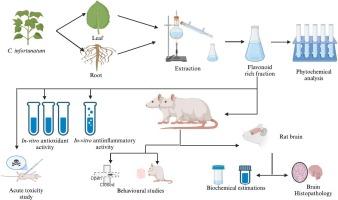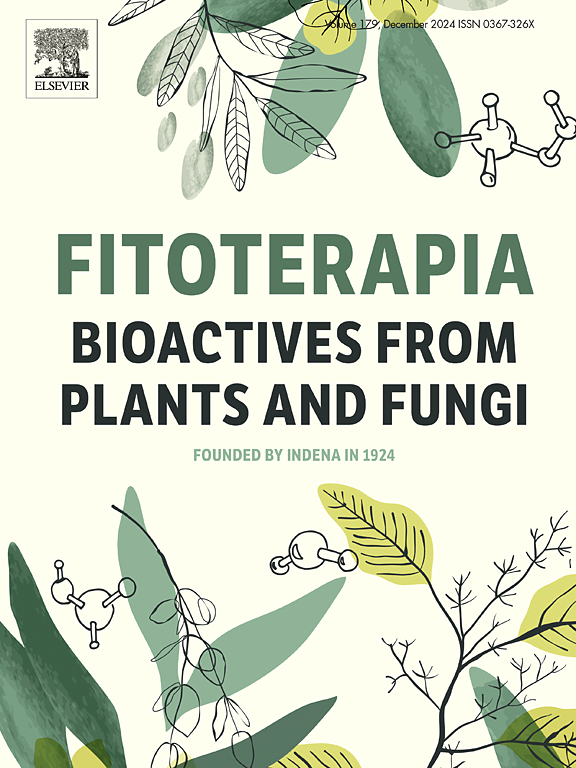Antioxidant, anti-inflammatory, and nootropic activities in flavonoid-rich fractions derived from Clerodendrum infortunatum leaf and root extracts: A comparative analysis
IF 2.6
3区 医学
Q3 CHEMISTRY, MEDICINAL
引用次数: 0
Abstract
Traditional medicine has long relied on plant-derived compounds, particularly flavonoids, for their antioxidant, anti-inflammatory, and neuroprotective properties. Clerodendrum infortunatum, an ethnomedicinally important plant, is rich in bioactive compounds and has shown hepatoprotective and antioxidant effects. The present study evaluated the antioxidant, anti-inflammatory, and nootropic potential of flavonoid-rich extracts from the leaves (CILM) and roots (CIRM) of this plant. Methanolic extracts were subjected to phytochemical screening, determination of total phenolic and flavonoid contents, and in-vitro assays for antioxidant and anti-inflammatory activities. The nootropic potential was assessed in scopolamine-induced amnesic rats using behavioral paradigms, biochemical markers of oxidative stress, and histopathological examination. Both extracts contained flavonoids, phenols, and related metabolites, with CILM showing higher phenolic (62.39 ± 1.25 mg GAE/g) and flavonoid (42.58 ± 2.05 mg QE/g) contents than CIRM. Antioxidant assays demonstrated dose-dependent radical scavenging activity, with CILM exhibiting greater potency (IC50 = 66.44 μg/mL). In-vitro anti-inflammatory testing revealed significant erythrocyte membrane stabilization, particularly with CILM (89.71 % protection at 400 μg/mL). Behavioral studies indicated that CILM (400 mg/kg) improved spatial memory and recognition performance comparable to Piracetam. Biochemical analysis confirmed reduced lipid peroxidation and inhibition of acetylcholinesterase activity, with CILM again showing superior efficacy. Histological evaluation supported these findings by demonstrating reduced neuronal degeneration and gliosis. Overall, methanolic extracts of C. infortunatum, especially from the leaves, displayed potent antioxidant, anti-inflammatory, and nootropic effects, highlighting their therapeutic potential for managing oxidative stress and cognitive impairments associated with neurodegenerative disorders.

黄酮提取物的抗氧化、抗炎和促智活性:比较分析
传统医学长期依赖于植物衍生的化合物,特别是类黄酮,因为它们具有抗氧化、抗炎和神经保护的特性。黄竹是一种重要的民族医学植物,具有丰富的生物活性成分,具有保护肝脏和抗氧化作用。本研究评估了这种植物的叶和根富含黄酮类化合物的提取物的抗氧化、抗炎和促智潜力。对甲醇提取物进行植物化学筛选,测定总酚和类黄酮含量,并进行体外抗氧化和抗炎活性测定。采用行为模式、氧化应激生化指标和组织病理学检查评估东莨菪碱诱导的健忘症大鼠的益智潜能。两种提取物均含有黄酮类、酚类及相关代谢物,其中总酚(62.39±1.25 mg GAE/g)和类黄酮(42.58±2.05 mg QE/g)含量均高于总提取物。抗氧化试验显示出剂量依赖性的自由基清除活性,其中CILM表现出更强的效力(IC50 = 66.44 μg/mL)。体外抗炎试验显示显著的红细胞膜稳定性,特别是CILM在400 μg/mL时(89.71%的保护)。行为学研究表明,CILM (400mg /kg)对空间记忆和识别性能的改善与吡拉西坦相当。生化分析证实了脂质过氧化和乙酰胆碱酯酶活性的降低,CILM再次显示出优越的疗效。组织学评估通过显示神经元变性和胶质瘤减少来支持这些发现。总的来说,黄樟的甲醇提取物,特别是从叶子中提取的,显示出有效的抗氧化、抗炎和益智作用,突出了它们在治疗氧化应激和与神经退行性疾病相关的认知障碍方面的治疗潜力。
本文章由计算机程序翻译,如有差异,请以英文原文为准。
求助全文
约1分钟内获得全文
求助全文
来源期刊

Fitoterapia
医学-药学
CiteScore
5.80
自引率
2.90%
发文量
198
审稿时长
1.5 months
期刊介绍:
Fitoterapia is a Journal dedicated to medicinal plants and to bioactive natural products of plant origin. It publishes original contributions in seven major areas:
1. Characterization of active ingredients of medicinal plants
2. Development of standardization method for bioactive plant extracts and natural products
3. Identification of bioactivity in plant extracts
4. Identification of targets and mechanism of activity of plant extracts
5. Production and genomic characterization of medicinal plants biomass
6. Chemistry and biochemistry of bioactive natural products of plant origin
7. Critical reviews of the historical, clinical and legal status of medicinal plants, and accounts on topical issues.
 求助内容:
求助内容: 应助结果提醒方式:
应助结果提醒方式:


